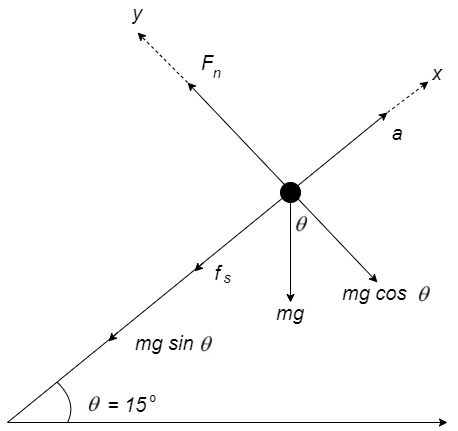
Concept explainers
(a)
To Calculate: The minimum distance to make the car stop.
(a)
Answer to Problem 48P
The minimum distance it takes to stop the car is
Explanation of Solution
Given Information:
An automobile is going up a
The coefficient of static friction between the tires and the road is
Formula Used:
Third equation of motion:
Where symbols have their usual meanings.
Calculation:
Initial velocity of the automobile
Final velocity of the automobile
Let the minimum displacement be
Let the acceleration of the car be
Free body diagram for automobile going up the inclined plane is shown below

Use the third kinematics relation
From the free body diagram, along the x-axis
Along the y-axis:
Substitute
Substitute the value of acceleration in
Conclusion:
Thus, the minimum stopping distance is
(b)
To Calculate: The minimum distance it would take to stop if the car were going down the grade.
(b)
Answer to Problem 48P
Explanation of Solution
Given Information:
An automobile is going up a
The coefficient of static friction between the tires and the road is
FormulaUsed:
Third equation of motion:
Where, symbols have their usual meanings
Calculation:
Initial velocity of the car
Final velocity of the car
Let the minimum displacement be
And let the acceleration of the car be
Use the third kinematic equation
Along the x-axis
And along the y-axis we conclude that,
Substitute
Substitute the value of acceleration in
Here, the negative sign indicates that the displacement of the car is in the opposite direction as in part
Conclusion:
Therefore, the magnitude of displacement is
Want to see more full solutions like this?
Chapter 5 Solutions
Physics for Scientists and Engineers
- A motorcyclist is coasting with the engine off at a steady speed of 20.0 m/s but enters a sandy stretch where the coefficient of kinetic friction is 0.70. Will the cyclist emerge from the sandy stretch without having to start the engine ifthe sand lasts for 15 m? If so, what will be the speed upon emerging?arrow_forward(b) The coefficient of kinetic friction between a 40 kg crate and the ware- house floor is 70% of the corresponding coefficient of static friction. The crate falls off a forklift that is moving at 3 m/s and then slides along the warehouse floor for a distance of 2.5 m before coming to rest. What is the coefficient of static friction between the crate and the floor?arrow_forwardI 00LLJ408 - Go.. Question Info and Solutions Blocks A and B of mass 5 kg and 10 kg respectively are placed on a Smooth inclined plane of Inclination 30, as shown. Block A and B are subjected to forces 5 N And 50 N respectively along the incline, as shown. The coefficient of friction between A andBis 0.50 find the frictional force between A and B in N is: (g= 10 ms SOH 300 Options Solution Fs=Static frictional force umg cos 30 (0.5) (5) (10) cos 30 21.6 N Let a be the acceleration of both the blocks along 5.27 PMarrow_forward
- You want to run up a hill starting from standstill. The hill is at an angle of 30 degrees with respect to hortizontal and has a coefficient of static friction of 0.3. How long will it take to reach a top speed of 25.2km/h?arrow_forwardA daredevil bicyclıst moves at 7.0m/s in a horizontal cirde in a cylindrical "weli of dea th" of radius 4.0 m. (A.) Draw the free - bady diagram (B) What is the minimum coefficient of friction required ? man riding a bikearrow_forward(a) If the coefficient of kinetic friction between tires and dry pavement is 0.80, what is the shortest distance in which you can stop a car by locking the brakes when the car is traveling at 28.7 m/s (about 65 mi/h)? (b) On wet pavement the coefficient of kinetic friction may be only 0.25. How fast should you drive on wet pavement to be able to stop in the same distance as in part (a)? (Note: Locking the brakes is not the safest way to stop.)arrow_forward
- A certain car traveling at 97 km/h can stop in 46 m on a level road. Determine the coefficient of friction between the tires and the road. Assume that the car starts skidding the moment the driver hits the brakes.arrow_forward"If the coeffecient of kinetic friction between tires and pavement is 0.80, what is the shortest distance in which you can stop a car by locking the breaks when traveling at 28.7 m/s?"arrow_forwardA force of 65N is needed to start an 8kg box moving across a horizontal surface. (A) Calculate the coefficient of static friction. (B) If the box continues to move with an acceleration of 1.4m/s². What is the coefficient of kinetic friction?arrow_forward
- A box weighing 1000 N is sitting in an inclined plane with an angle of 45°. Given the coefficient of friction of 0.25, calculate the horizontal force that can start the box the moving forward.arrow_forwardA 45 kg box is at rest at one end of a 2 meter board. That end of the board is slowly raised at an incline until the box starts to slide. At that point, the angle is at 34 degrees. The coefficient of kinetic friction is 0.50N. Please help me calculate the coefficient of static friction between both the box and the board?arrow_forwardShoes made for the sports of boulderingand rock climbing are designed to provide a great deal of frictionbetween the foot and the surface of the ground. Such shoes on smoothrock might have a coefficient of static friction of 1.2 and a coefficient ofkinetic friction of 0.90. A person wearing these shoes stands on a smooth, horizontal rock. She pushes against the ground to begin running. What is the maximum horizontal acceleration she can have without slipping? (a) 0.20g; (b) 0.75g; (c) 0.90g; (d) 1.2g.arrow_forward
 University Physics Volume 1PhysicsISBN:9781938168277Author:William Moebs, Samuel J. Ling, Jeff SannyPublisher:OpenStax - Rice University
University Physics Volume 1PhysicsISBN:9781938168277Author:William Moebs, Samuel J. Ling, Jeff SannyPublisher:OpenStax - Rice University
